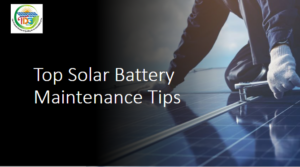Top Solar Battery Maintenance Tips - Similar to other batteries, solar batteries require little and consistent care. With the increasing interest in solar energy, the need for adequate maintenance of solar batteries is also increasing. To guarantee optimal performance and efficiency, solar batteries are an essential part of any solar power system and need to be properly maintained. TDG Solar offers a range of tips and advice for maintaining the optimal operation of your solar batteries. In this blog, we will discuss the top solar battery maintenance tips and some steps you can take to set up the right conditions so that your solar battery lasts as long as possible.

Table of Contents
What maintenance do Solar Batteries Require?
The purpose of battery care and maintenance is to improve battery performance and longevity. The highly variable characteristic of battery life is dependent on a wide range of variables including depth of discharge and storage temperature. Sulfation, a process where sulfur crystals grow on the battery's lead plates and hinder chemical reactions, is responsible for about 80% of failures. Low electrolyte levels or battery charge can cause sulfation. In flooded batteries, it is important to monitor, manage, and regulate these two parameters due to the risks associated with sulfation. It requires distilled water, a digital voltmeter, a temperature-compensated hydrometer, and proper safety equipment.
Top 5 Solar Battery Maintenance Tips
Here are some top solar battery maintenance tips you need to consider to maximize the performance of your solar batteries –
Check the Battery Fluid Level
The only battery types where the fluid level can be checked are unsealed batteries. Take a brief look inside your battery and remove the cap to begin operation. After that, you should fill it with a distilled water unit so that you cannot see any metal surface. To avoid leakage, be careful not to overfill your batteries with water. Fortunately, most batteries have a fill line that shows the electrolyte level.
Check the Depth of Discharge
This shows how much charge your battery has spent before recharging. For example, if you use all the energy stored in your battery you reach 100% depth of discharge. Different battery chemistries are optimized for different depths of discharge – so what works well for a lead lithium-ion battery may not work well for a lead acid battery. To learn more about how much of your battery capacity you can use at one time without affecting the long-term performance of your solar battery installer.
Operating and Storage Temperature
Not every battery can be used in indoor and outdoor settings. When your installer is designing your battery system, be sure to consider whether your battery can be installed outside or if it must be installed in an air-conditioned space, such as a garage or basement. The overall performance of your battery can be significantly affected if you expose it to temperatures outside its working range.
Cleaning Your Solar Batteries
Another good tip for solar battery maintenance is to clean your batteries regularly. For example, you can make a cleaning solution by mixing water, baking soda, and purified water. After that, use the battery terminal cleaner brush to clean your battery. After a quick rinse of your battery terminals with water, seal them or use a high-temperature grease (like WD-40). For solar panels to produce their renewable energy efficiently, clean the batteries in them at least twice a year.
Avoid Overcharging Your Battery
Higher charging voltage from solar panels leads to higher AH in the battery and ultimately leads to overcharging. Controlling the output voltage of solar batteries is the easiest way to control the charging of solar batteries. If you have a solar battery, you should know that overcharging solar battery storage can cause serious damage. When solar batteries are overcharged to high voltage, they can be permanently damaged or cause dangerous fires.
Conclusion
Every solar battery in the Australian market comes with a pre-set battery management system, which controls the operation of the battery so that you do not have to worry about how to operate the battery TDG Solar is one of Australia's top solar companies, and we provide the best quality solar batteries. We have experienced professional teams to handle home solar system installation and solar battery system installation. We are here to help you provide, install, and maintain your solar system to suit your needs and budget.
Contact Details
Name – TDG SOLAR
Address – 1/48 Vinnicombe Drive, Canning Vale WA 6155 Perth
Phone number – 1300TDGSOL (1300 834 765)
FAQs About Top Solar Battery Maintenance Tips
How do you know if the solar battery is 100% charged?
Checking the battery voltage is the simplest way to determine if a solar battery is fully charged. Approximately 12.7 volts indicates a fully charged 12-volt battery, while approximately 25.4 volts indicates a fully charged 24-volt battery.
How do I keep my solar battery healthy?
If you don't charge solar batteries for a long time, the batteries can degrade, making them less efficient at best and useless at worst. Make sure that your solar batteries are charged from time to time and check whether the batteries are adequately charged or not.





